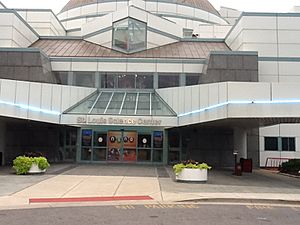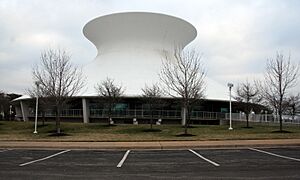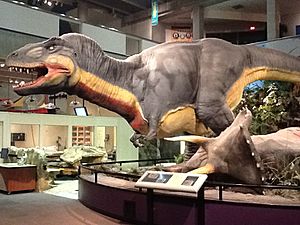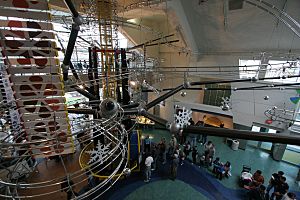Saint Louis Science Center facts for kids
 |
|

Saint Louis Science Center Entrance
|
|
| Lua error in Module:Location_map at line 420: attempt to index field 'wikibase' (a nil value). | |
| Established | 1963 |
|---|---|
| Location | 5050 Oakland Ave, St. Louis, Missouri, United States |
| Public transit access | |
The Saint Louis Science Center is a super cool place in St. Louis, Missouri. It's a big science museum and planetarium located right next to Forest Park. It first opened as a planetarium way back in 1963.
Imagine a place with over 750 different things to see and do! It's one of the biggest science centers in the whole United States, covering more than 300,000 square feet.
Contents
The James S. McDonnell Planetarium
The idea for the first building of the Science Center, the Planetarium, started in 1955. The city set aside $1 million to build it. After looking at different spots, they decided to build it in the southern part of Forest Park. An old police station was taken down in 1960 to make space for it. The plan was to build a planetarium, a science museum, and a natural history museum all together.
The Planetarium was designed by an architect named Gyo Obata. He made it look really unique, almost like a spaceship that landed on Earth! Later, he also designed the National Air and Space Museum in Washington, D.C.. A man named James Smith McDonnell, who helped start a big aerospace company called McDonnell Douglas, gave $200,000 for special equipment like the star projector. Because of his generous gift, the building was named after him in 1964.
Today, the McDonnell Planetarium has a super advanced ZEISS UNIVERSARIUM Mark IX Star Projector. This amazing machine was put in place in 2001. It's one of only three like it in the United States and just thirteen in the whole world! It creates incredibly bright and clear star shows.
The Main Science Center Building
In 1972, the Museum of Science and Natural History, which was in a different park, started getting money from sales tax. In 1983, this museum bought the Planetarium from the city. They closed it for a while to make it even better. On July 20, 1978, the Planetarium reopened as the Saint Louis Science Center.
Then, on November 2, 1991, something big happened! As part of a $34 million expansion, a brand new building opened across the highway from the Planetarium. This new building made the Science Center seven times bigger! It was built where an old brewing company used to be. A cool Skybridge connects the new main building to the Planetarium over the highway. The new exhibits in the main building teach you all about Earth science, new technology, life sciences, physical science, and chemistry. Within just two months, the newly expanded Saint Louis Science Center became the most visited science center in the world!
One of the most famous parts of the Science Center is the five-story OMNIMAX theater. It has a huge dome-shaped screen that shows amazing educational films and documentaries all year long. Sometimes, it even shows popular movies! In 2019, the OMNIMAX theater got a big upgrade. It now uses a special laser projection system and has new sound technology, a better screen, and comfier seats.
Exploradome and GROW Exhibits
On February 8, 1997, a large, air-supported building called the Exploradome was added next to the main building. It added 18,000 square feet of space! It was used for special traveling exhibits, extra classrooms, and big group events. Some cool exhibits that visited included shows about the famous RMS Titanic ship and Body Worlds, which showed preserved human bodies. The Exploradome was taken down on June 24, 2013, after 16 years, to make room for new plans.
In 2016, the museum finished its biggest new addition in 25 years. This new area is called GROW. It has a huge 5,000 square foot pavilion that can change to host different exhibits and events. The main focus of GROW is to teach visitors about agriculture (farming) and how new technology is changing the way we grow food.
Special Exhibitions and Events
The Saint Louis Science Center often hosts special events and exhibitions.
WeatherReadyFest
In 2018, the Science Center hosted an event called WeatherReadyFest. This event featured talks, demonstrations, and displays from the National Weather Service and other groups. It taught people all about weather and how to be prepared for it.
Washington University Outreach
Students from Washington University in St. Louis who study how the brain works have created special exhibits for the Science Center. They have been doing this since 2008 as part of a program to share their knowledge with the public.
See also
- X Prize Foundation
- Erik Lindbergh
- List of science centers




